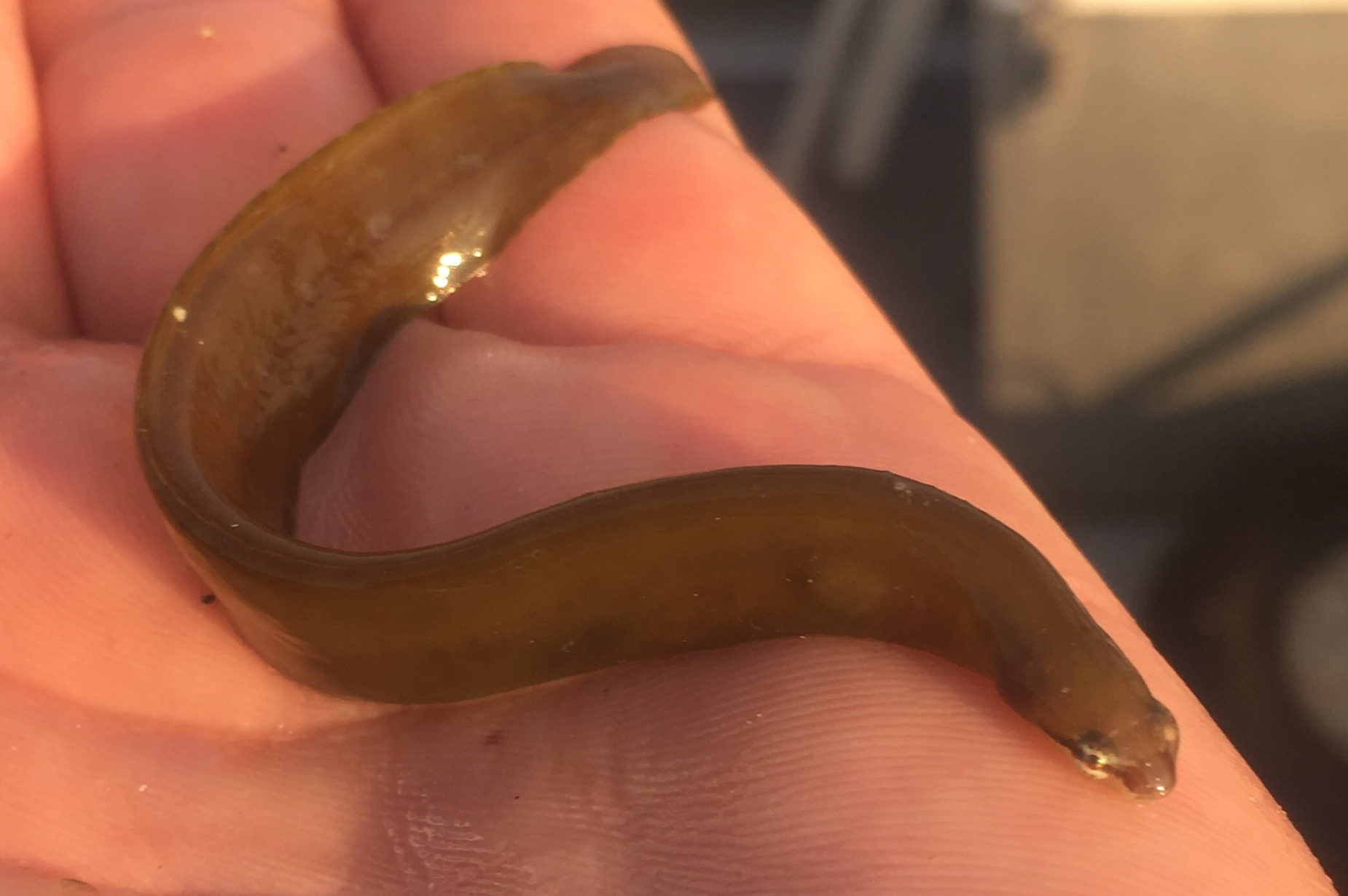Hunchback Shore Eel, Alabes gibbosa Hutchins & Morrison 2004

A Hunchback Shore Eel, Alabes gibbosa, from Boullanger Island Conservation Reserve, Western Australia, May 2018. Source: Vin Rushworth / iNaturalist.org. License: CC By Attribution-NonCommercial
Summary:
A bright green to greenish-brown or plain brown shore eel, often with fine dark spots sprinkled on the body (largest along the midline), a narrow dark brown stripe through the eye, a mostly brownish snout and upper lip, and a whitish lower lip.
The Hunchback Shore Eel has a relatively small head, a posterior nasal pore, and a prominent hunchback-like appearance.
The Hunchback Shore Eel has a relatively small head, a posterior nasal pore, and a prominent hunchback-like appearance.
Cite this page as:
Bray, D.J. 2021, Alabes gibbosa in Fishes of Australia, accessed 04 Jul 2025, https://fishesofaustralia.net.au/home/species/1143
Hunchback Shore Eel, Alabes gibbosa Hutchins & Morrison 2004
More Info
|
Distribution |
Endemic to south-western Australia from Safety Bay to Jurien Bay, Western Australia. Inhabits shallow seagrass beds, at depths to 4 metres. |
|
Features |
Caudal fin 9–11 rays; Vertebrae (total) 68 (19 precaudal). Body elongate, very compressed, dorsal profile rising abruptly over level of gill opening, reaching maximum depth about midway between snout tip and caudal fin base, maximum body depth 7.8 (7.9–9.5) in SL, maximum body width 14.8 (11.6–22.6), width at level of gill slit 19.1 (16.7–27.3), all in SL; head slightly rounded to somewhat pointed anteriorly, a little wider than body (head width 1.6 [1.5–2.1] in HL), HL 9.8 (9.8–11.4) in SL; snout triangular in dorsal view with rounded extremity, length 5.5 (4.0–5.3) in HL; diameter of orbit 4.2 (4.2–4.9) in HL, somewhat greater than bony interorbital width (5.5 [5.2–8.9] in HL); total of six cephalic pores on each side of head, consisting of two postocular pores widely separated, one posterior nasal pore, one anterior nasal pore and two lacrymal pores; gill opening a moderately narrow slit, length 3.9 (3.3–3.9) in HL; mouth slightly inferior, upper lip projecting slightly forwards of lower lip; rear corner of mouth below anterior margin of eye or slightly behind; teeth small, conical, somewhat canine-like, 1–2 rows in upper and lower jaws. Bases of dorsal and anal fins long, insertion of dorsal fin usually well posterior to vertical through urogenital opening (snout to insertion 2.5 [2.2–2.7] in SL), (3.25 in SL); insertion of anal fin a short distance posterior to urogenital opening (snout to insertion 2.4 [2.0–2.8] in SL). Total vertebrae 68 vertebra (19 precaudal), with last epineural on 20th vertebra (radiographs of two additional paratypes indicate counts of about 19+49– 50 = 68–69). |
|
Colour |
Overall apple green, somewhat translucent (internal organs slightly visible), with a sprinkling of dusky and pale spots on body, largest on midside of body following course of lateral-line (each lateral line papilla enclosed in a minute white spot, surrounded by a larger dusky spot); narrow dark brown stripe continues from snout, through eye, to preopercular margin; snout and upper lip mostly brownish, lower lip whitish; in life, dusky spots may be very faint and white spots—especially those on rear portion of body—may be more silvery and considerably larger in size; body colour continued on to fins, with indications of faintly darker cross bars. |
|
Similar Species |
Alabes gibbosa differs from other species of Alabes in having the following combination of characters: a deep body (7.8–9.5 in SL), which usually exhibits a gibbous dorsal profile, a relatively large gill slit (3.3–3.9 in HL), moderate-sized rudimentary pelvic fin without obvious pelvic spines or fin rays, two postocular pores, one post nasal pore above eye on each side of head, and a unique colour pattern. A. gibbosa is most similar to its apparent sister species, A. brevis, differing in its deeper and larger body (maximum size 91 mm SL versus 36 respectively), presence of a post nasal pore (usually absent in the latter species), more vertebrae (68–69 versus 61–62), and different coloration (males of A. gibbosa never develop a tigerlike pattern of irregular dark bars on the side of the head as found in A. brevis). |
|
Etymology |
The specific name gibbosa is from the Latin gibbus (= hump) in reference to its gibbous or hunchbacked dorsal profile. |
|
Species Citation |
Alabes gibbosa Hutchins & Morrison 2004, Rec. Aust. Mus. 56: 151, fig. 3. Type locality: bay on eastern side of Carnac Island, Western Australia, 32°07'S, 115°40'E, seagrass beds, depth 3-4 m. |
|
Author |
Bray, D.J. 2021 |
|
Resources |
Hunchback Shore Eel, Alabes gibbosa Hutchins & Morrison 2004
References
Hutchins, J.B., 1991. Southern Australia’s enigmatic clingfishes. Australian Natural History 23(8): 626–633 (p. 630, fig, as Alabes brevis)
Hoschke, A., Whisson, G. & Moore, G.I. 2019. Complete list of fishes from Rottnest Island. pp. 150-161 in Whisson, G. & Hoschke, A. (eds) The Rottnest Island fish book. 2nd ed. Perth : Aqua Research and Monitoring Services.
Hutchins, B. & Morrison, S. 2004. Five new fish species of the genus Alabes (Gobiesocidae: Cheilobranchinae). Records of the Australian Museum 56: 147-158 https://doi.org/10.3853/j.0067.1975.56.2004.1426



